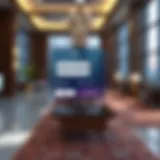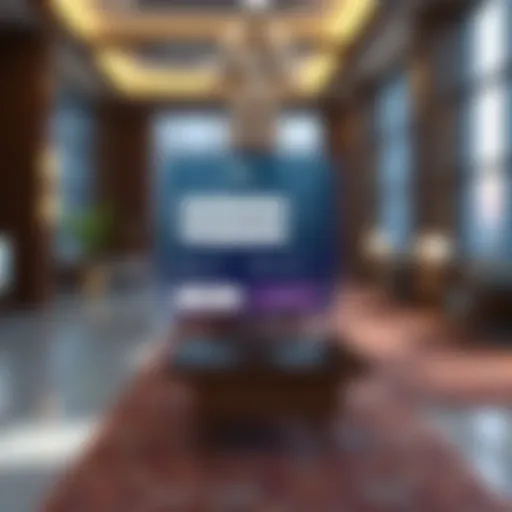Al Jaddaf Metro Station: A Key to Urban Growth
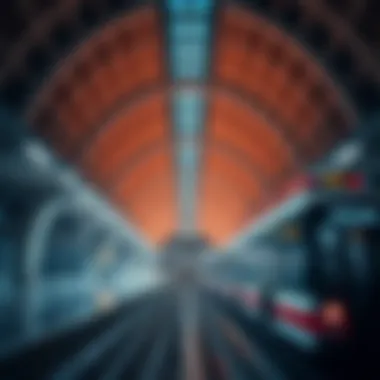

Intro
In the bustling metropolis of Dubai, Al Jaddaf Metro Station serves as more than just a stop on the city’s extensive public transport system; it stands as an emblem of urban connectivity and development. With its strategic positioning, it links various significant districts while playing a pivotal role in Dubai’s real estate evolution. In this exploration, we will peel back the layers of Al Jaddaf Metro Station, examining its architectural design, the ease of transit it provides, and its transformative effects on property values in the surrounding area. We will also delve into the broader implications of its presence on urban planning and sustainability initiatives.
As we navigate this discussion, it’s essential to understand that Al Jaddaf is located near a confluence of key neighborhoods, commercial hubs, and cultural landmarks. This prime location positions the station as a crucial player in the city’s transit ecosystem. Let’s take a closer look at the current market trends surrounding this vibrant locale.
Intro to Al Jaddaf Metro Station
Al Jaddaf Metro Station represents not just a transportation hub, but a pivotal point in the expanding urban landscape of Dubai. It is a microcosm of the city itself: dynamic, ever-evolving, and essential to understanding the broader narrative of connectivity and growth. This section breaks down the importance that Al Jaddaf holds within Dubai's metropolitan framework, delving into its contributions to both transit and urban development.
Overview of Dubai's Metro System
Dubai's Metro system is a sophisticated network that caters to millions of passengers each year. Launched in 2009, the system radically transformed public transportation in the city, providing a modern, efficient alternative to traditional means of commuting. The overall structure consists of over 75 kilometers of track, seamlessly linking key districts and neighborhoods.
Al Jaddaf Station, part of the Green Line, plays a vital role in this network. Located strategically between busy business locales and residential areas, it facilitates smoother transit for residents and visitors alike. With its automated trains and user-friendly design, Dubai's Metro exemplifies how a city can innovate and adapt to rapid growth while addressing traffic congestion.
Significance of Al Jaddaf Station
Al Jaddaf Station is more than just a stop on the Metro line. It's a gateway, connecting people not only to other parts of Dubai but also to the very essence of the city's cultural and economic vibrancy. Here’s why it stands out:
- Access to Key Locations: Al Jaddaf is situated near several significant landmarks, including the Dubai Creek and various hotels, making it a convenient stop for both tourists and residents.
- Boosting Local Economy: By increasing foot traffic, the station stimulates local businesses, from cafes to entertainment venues. Economic enhancement is one of the critical outcomes of improved transportation links.
- Community Development: This Metro stop acts as a catalyst for urban renewal projects in the surrounding neighborhoods, encouraging further investment in infrastructure and services.
"Al Jaddaf Station not only brings people together but also fosters community growth and economic opportunities, embodying Dubai's ethos of progress."
In summary, understanding the role of Al Jaddaf Metro Station provides valuable insights for investors, homeowners, and urban planners. The station's significance transcends transit; it encapsulates the essence of Dubai’s ambitious vision—where connectivity catalyzes urban enhancement, ultimately shaping a vibrant metropolis.
Architectural Design and Features
The architectural design and features of Al Jaddaf Metro Station are not merely about aesthetics; they serve as a fundamental aspect that intertwines functionality, convenience, and sustainable urban development. The station embodies the spirit of modern Dubai—reflecting its ambition of becoming a global city while addressing the practical needs of its residents and visitors. These design elements contribute overall to the strategy of enhancing public transport use and establishing an inviting urban atmosphere.
Design Aesthetic
When you first approach Al Jaddaf Metro Station, the unique facade immediately captures attention. The exterior design melds contemporary elements with cultural motifs, which resonates well with Dubai's heritage. The sweeping lines of the station's structure mimic the flow of the water bodies that surround it, creating a sense of harmony between the man-made environment and nature. Large glass panels let in ample light, giving the platform and waiting areas an airy feel, making the station not just a transit point but a welcoming space for commuters.
Many might not realize this, but a well-thought-out aesthetic can elevate the user experience dramatically. Travelers passing through Al Jaddaf enjoy not only convenience but also an environment that encourages them to take a moment of pause before continuing on their journey. This beauty blended with utility certainly creates a memorable impression, making the station a focal point in the area.
Construction Materials
The materials chosen for Al Jaddaf Metro Station play an equally vital role in its functionality and aesthetics. The structural elements mainly employ reinforced concrete and steel, supporting the station's futuristic design while ensuring its durability. Notably, sustainable construction methods were a priority—having incorporated recycled materials wherever feasible. For example, some of the interior finishes involve reconstituted timber and innovative tiling sourced from sustainable producers, thus minimizing the environmental footprint.
Another crucial aspect to note about the construction materials is their contribution to the station's performance. Weather in Dubai can be unforgiving, with soaring temperatures and occasional dust storms. Therefore, the use of high-performance insulation materials in the roof and walls helps maintain a comfortable climate within the station. This attention to detail doesn't just affect commuters' comfort; it also has long-term implications on maintenance costs and energy efficiency.
Accessibility Features
Accessibility within Al Jaddaf Metro Station is paramount, ensuring that all users, regardless of physical ability, can navigate the station with ease. For starters, the station features wide, clearly marked pathways and ramps that allow easy movement for individuals using wheelchairs or pushing strollers. Elevators are strategically positioned, making it convenient for everyone to access different levels without hassle. Moreover, tactile paving and audible signals guide visually impaired passengers throughout the station.
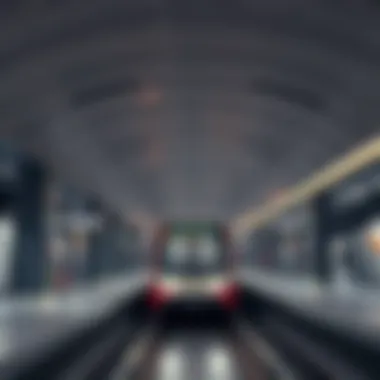
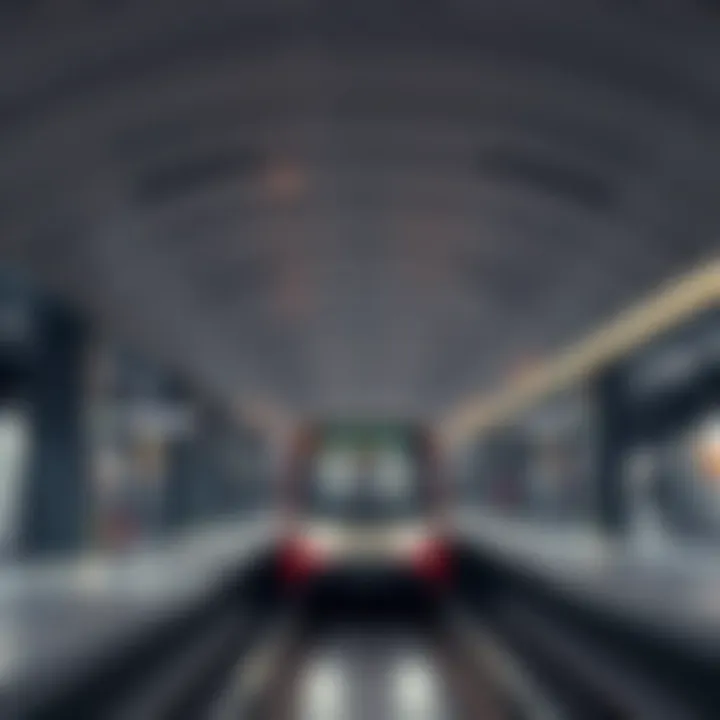
Additionally, Al Jaddaf integrates modern technology to assist with accessibility. Live updates on train schedules and platform changes can be easily accessed via digital boards, spacious waiting areas provide comfort, and restroom facilities are designed with accessibility in mind. These features demonstrate that thoughtfulness for all user groups is crucial, as it not only fosters inclusivity but also enhances the station's overall efficiency.
In a city striving for excellence, Al Jaddaf Metro Station stands as a benchmark for future urban designs, balancing beauty, utility, and sustainability seamlessly.
By understanding the architectural design and features, investors and homeowners can appreciate how such considerations elevate the value and desirability of real estate in the vicinity of the station. The attention to detail in design becomes an integral part of the urban tapestry of Dubai, making Al Jaddaf not just a place to travel through, but a landmark unto itself.
Connections to Key Areas in Dubai
In the dynamic fabric of Dubai's urban landscape, the Al Jaddaf Metro Station serves as a pivotal node that interlinks various significant neighborhoods and districts. This connectivity has sizable implications for residents and investors alike. The station is not just a transit point; it's a major gateway facilitating access to key areas, making commuting easier and more efficient while reshaping the trade and real estate dynamics.
Linking Major Destinations
Al Jaddaf Metro Station is strategically positioned, making it a cornerstone of travel between some of Dubai's most notable locales such as Dubai Healthcare City, Dubai Festival City, and Downtown Dubai. The close proximity of these areas allows commuters to travel seamlessly between essential amenities and luxurious landmarks.
For instance, a mere 15-minute ride can take someone directly from Al Jaddaf to the vast shopping and entertainment options in Dubai Festival City. This ease of access not only enhances the lifestyle offerings for the residents in the immediate vicinity but also attracts newcomers looking to capitalize on what these districts have to offer.
Consider the rising demand for real estate properties in Al Jaddaf itself. With the ease of transportation to major destinations, potential homeowners are drawn to properties that boast both convenience and connectivity.
Interconnectivity with Other Transport Modes
A key feature of Al Jaddaf Metro Station is its integration with alternative transport systems. The synergy between the metro service, taxis, and bus lines creates a cohesive transport network that maximizes user experience. Commuters can easily switch from the metro to a taxi, or pick up a bus, broadening their options without much hassle.
This seamless transition is crucial for both daily commuters and first-time visitors to Dubai. For example:
- Travelers heading towards Dubai International Airport can hop on a bus directly from the station, making their journey smooth and efficient.
- Business professionals can take a brief metro ride to reach the numerous companies located within the Dubai Healthcare City area, without the typical hassle of traffic jams.
🔍 Advantages of this interconnectivity include:
- Reduced Travel Time: Commuters spend less time on the road.
- Enhanced Accessibility: Amore extensive transport network means better access to employment opportunities.
- Environmentally Friendly: Promotes public transport use, aligning with sustainable practices.
"Connectivity is the lifeblood of urban development; without it, cities struggle to thrive and grow."
Impact on Real Estate Values
Understanding the impact of Al Jaddaf Metro Station on real estate values is crucial, particularly in a rapidly evolving city like Dubai. The station plays a pivotal role in shaping the real estate landscape, influencing property prices, demand, and investment patterns.
Market Trends in Al Jaddaf
Al Jaddaf has seen significant shifts in the real estate market since the inception of its metro station. The area is transforming from a somewhat under-the-radar locale into a hotspot for both investors and residents. Property prices have been witnessing a gradual uptick, reflecting growing confidence in the region as a viable residential and commercial option.
- Increased Property Demand: With the metro's accessibility, more residents are seeking homes in Al Jaddaf, leading to a noticeable increase in property demand. Rents and sale prices are on the rise, enticing landlords and buyers alike.
- New Developments: Developers are keenly eyeing the area for new projects. There's a mix of modern apartments and commercial spaces aimed at both the expatriate community and local residents. The introduction of luxurious amenities alongside convenient transport options adds significant allure.
- Long-term Projections: Experts predict sustained growth in real estate values in the coming years. As the area continues to develop and integrate with Dubai's broader urban planning initiatives, investors are increasingly looking to capitalize on this upward trend.
Comparative Analysis with Nearby Areas
When juxtaposed with nearby areas like Dubai Healthcare City and Cultural Village, Al Jaddaf exhibits a distinctive growth trajectory. The strategic location allows easy access not only to the metro but also to key attractions around the city.
- Price Comparisons: While neighborhoods such as Dubai Creek and Jumeirah attract high-end buyers, Al Jaddaf offers more affordable options with comparable amenities. This price difference appeals to middle-income families and expats looking for value.
- Accessibility: Al Jaddaf’s connectivity through the metro significantly enhances its attractiveness compared to adjacent areas. Properties in neighborhoods lacking similar transit links tend to lag behind in terms of valuation and demand, making Al Jaddaf a much more favorable option.
- Future Growth Potential: Unlike some saturated areas in Dubai, Al Jaddaf is on an upswing, with numerous planned developments. As public and private sectors continue to invest in infrastructure and facilities, Al Jaddaf’s potential for appreciation appears solid.
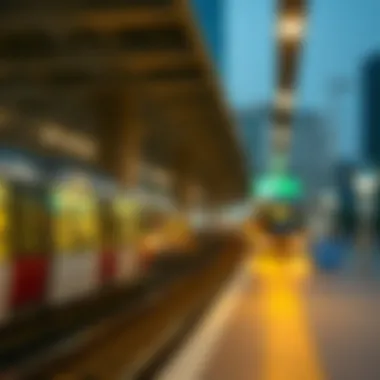
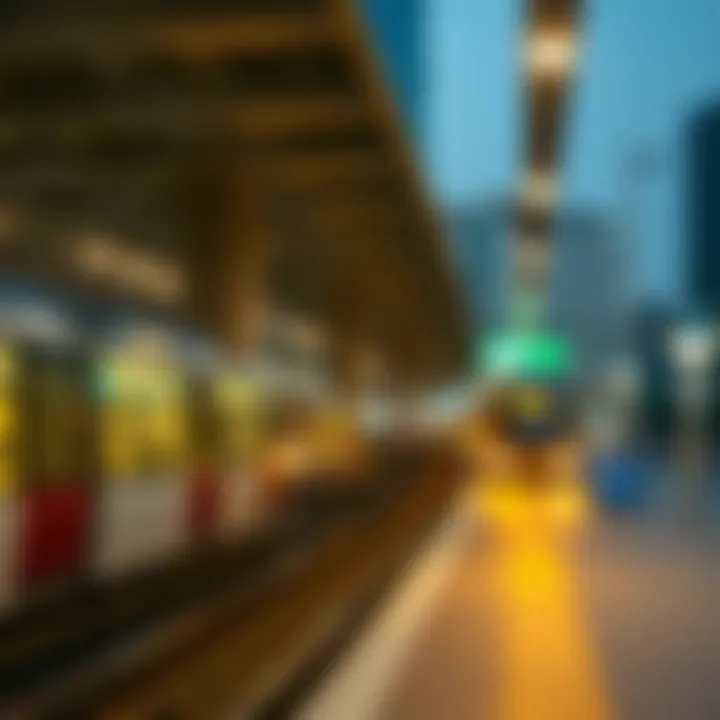
Investment Opportunities
The growth of Al Jaddaf Metro Station opens a treasure trove of investment opportunities for discerning buyers and developers. The combination of strategic location and burgeoning real estate market is enticing for various stakeholders.
- Residential Investments: For those considering rental properties, the increasing population and demand for homes due to metro connectivity make Al Jaddaf an attractive proposition. Investors can expect healthy yields as rents continue to rise with population influx.
- Commercial Prospects: With the surge in residents and visitors facilitated by the metro, commercial spaces are ripe for investment. Retail and food service businesses are expected to thrive, especially those positioned near the station.
- Government Initiatives: The UAE government’s initiatives aimed at boosting economic growth and improving infrastructure further sweeten the deal. Policies designed to attract foreign investment can enhance property rights and provide stability for long-term investments.
Role in Enhancing Sustainability
Sustainability is no longer just a buzzword; it's become the backbone of forward-thinking urban design. In the bustling city of Dubai, Al Jaddaf Metro Station plays a crucial role in advancing sustainable practices within its transportation framework. This not only serves commuters efficiently but also aligns with larger city-wide initiatives that prioritize environmental stewardship. The integration of sustainable design principles enhances the station's functionality while contributing positively to the urban landscape.
Eco-Friendly Design Considerations
One of the most remarkable aspects of Al Jaddaf Metro Station is its eco-friendly design. The station showcases cutting-edge architectural ingenuity that effectively marries aesthetics with environmental responsibility. Architects and urban planners have focused on using sustainable materials, optimizing natural light, and ensuring effective energy use. For instance, the station incorporates solar panels which generate a significant portion of its energy needs. This is not just a proactive approach but a necessary measure to reduce the carbon footprint of urban travel.
Additionally, the station features green roofs and vertical gardens, which not only contribute to biodiversity but also help regulate temperatures, enhancing comfort for commuters.
- The use of local materials reduces transport emissions.
- Rainwater harvesting systems are installed to minimize water wastage.
- Intelligent lighting systems adjust based on occupancy, saving energy.
The design elements reflect a commitment to sustainability, leading the way for other infrastructure projects in the region to follow suit.
Encouragement of Public Transport Use
Al Jaddaf Metro Station significantly encourages the use of public transport, which is a critical component of sustainable urban mobility. By making public transport a viable option, the station helps to alleviate road congestion, lower emissions, and improve air quality in one of the world's fastest-growing cities.
The strategic location mid-way between various key destinations means that residents and visitors alike find it convenient to rely on the metro. To further facilitate this transition, the station features extensive bike racks and designated drop-off zones, making it easy for commuters to combine cycling or car travel with metro rides. Moreover, the integration of signage and real-time information systems enables smoother transitions for users, reducing wait times and enhancing overall satisfaction.
Here are some ways Al Jaddaf Metro promotes public transport usage:
- Fare Incentives: Offering discounted fares during peak hours.
- Collaborations: Partnering with local businesses to give discounts to travelers.
- Awareness Campaigns: Running initiatives aimed at educating the public about the environmental benefits of using public transit.
Ultimately, Al Jaddaf Metro Station stands as a model of how effective planning and design can lead to enhanced sustainability, not only contributing to the immediate area but setting a precedent for urban transport globally.
Future Development Plans
The future development plans surrounding Al Jaddaf Metro Station are intricately linked to the continued growth and expansion of Dubai as an avant-garde urban center. These plans highlight a commitment to enhancing the station’s role not just as a transit point, but as a catalyst for broader urban rejuvenation. Investors and homeowners alike should keep a close eye on these evolving projects since they could significantly impact property values and community dynamics in the region.
Projected Enhancements
Projected enhancements around Al Jaddaf aim to amplify both functionality and its urban appeal. With the city's ambition set on retaining its global status as a leader in modernity, planning authorities have outlined several key areas for improvement:
- Infrastructure Upgrades: Upgrading the current facilities to provide more seamless transitions between different transport modes. This includes improved signage, waiting areas, and digital information systems to aid commuters.
- Commercial and Residential Development: Plans to introduce mixed-use developments that combine commercial spaces, residential units, and recreational areas can create a vibrant community hub. High-rise towers with retail spaces at their bases could contribute to a thriving neighborhood where people live, work, and enjoy leisure activities.
- Green Spaces: New parks and gardens in and around the station are designed to offer residents and visitors a breath of fresh air amidst the bustling urban environment. These green spaces are expected to feature walking paths, seating areas, and possibly water features to enhance aesthetics and ecological benefits.
"Investing in infrastructure is not just about bricks and mortar; it’s about creating a space where communities can flourish.”
These enhancements are projected to elevate Al Jaddaf’s status and allure, encouraging not just local usage but also attracting visitors and businesses.
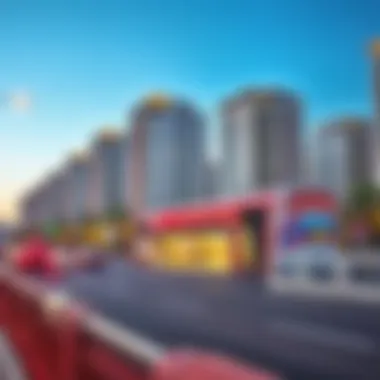
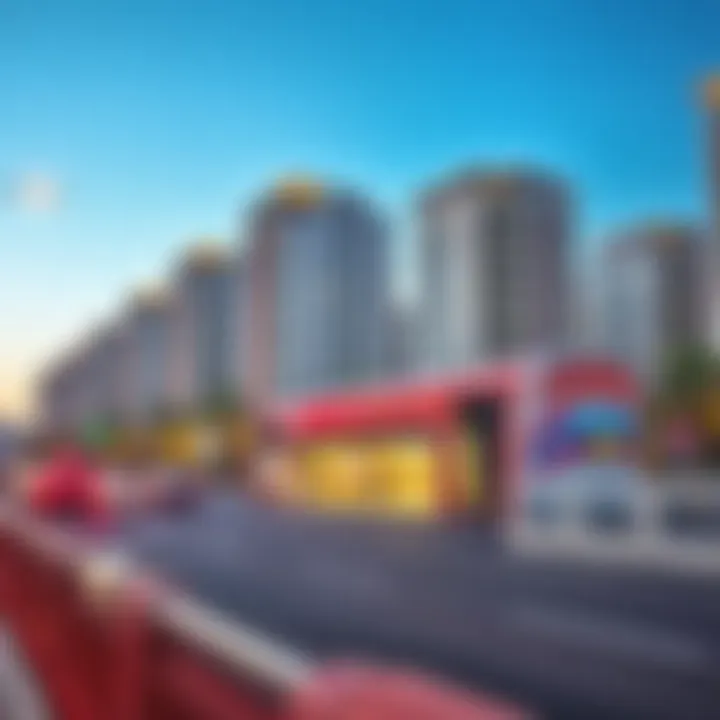
Integration with Urban Renewal Projects
The integration of Al Jaddaf Metro Station with ongoing urban renewal projects is a pivotal consideration that will redefine its position within Dubai’s urban landscape. This symbiotic relationship can yield numerous benefits:
- Economic Growth: Aligning the station’s development with urban renewal initiatives can stimulate economic opportunities. More businesses and services will likely emerge, benefiting from increased foot traffic and improved accessibility.
- Community Revitalization: Urban renewal often focuses on enhancing the living standards of existing communities. By coordinating efforts, stakeholders can ensure that developments at Al Jaddaf address local needs and encourage inclusivity.
- Sustainable Transportation Initiatives: Projects that look to enhance transport interconnectivity can reinforce Dubai’s commitment to sustainability. Integrating cycling paths and pedestrian walkways connected to the metro station will promote environmentally friendly modes of transport.
The future plans, thus, reflect a holistic vision that goes beyond merely facilitating transportation. They center on creating a comprehensive urban experience that captures the essence of community living while promoting vitality in real estate. Investors and future residents would do well to monitor how these developments unfold, as they are likely to play a significant role in shaping the growth trajectory of Al Jaddaf and its surroundings.
Challenges and Considerations
Understanding the challenges and considerations surrounding Al Jaddaf Metro Station is crucial, as it plays a pivotal role in the dynamics of transit and urban development in Dubai. By addressing these elements, we can also appreciate the intricacies involved in optimizing station functionality while meeting the diverse needs of its strategic location. The challenges that surface can have lasting impacts not just on the station itself, but on the wider community and economy surrounding it.
Operational Challenges
The operational challenges faced by Al Jaddaf Metro Station reflect the complexities of daily management and infrastructural requirements necessary for effective transit options. With a steady stream of commuters flowing in and out, ensuring timely services and efficient crowd management remains paramount. Factors that contribute to operational hurdles include:
- Maintenance of Facilities: Regular upkeep of infrastructure is essential. Delays in maintenance can lead to service interruptions, affecting commuter trust.
- Resource Management: Allocating sufficient human resources efficiently to deal with passenger flow during peak hours can be daunting. Trains must run on schedule while staff manage unexpected situations, like equipment failures or emergencies.
- Integration with Other Transport Modes: Ensuring seamless connectivity with other transit options can pose its own challenges. Riders changing from metro to bus, for example, should experience minimal disruption.
These operational concerns warrant attention because they directly influence the level of satisfaction among users. If commuters consistently experience delays or difficulties, the trust in public transportation diminishes, which could deter potential users who might otherwise favor metro travel over personal vehicles or taxis.
Socio-Economic Factors
On the socio-economic front, the implications of Al Jaddaf Station can be far-reaching, as a well-planned transit hub doesn't just support the movement of people, but also enhances local economies. The challenges in this arena can include:
- Economic Disparities: While the station can catalyze growth in the vicinity, not all nearby communities are set to benefit equally. Wealthier areas might attract more infrastructure investment, leaving low-income neighborhoods at a disadvantage, hindering their socioeconomic mobility.
- Job Creation vs. Job Accessibility: The jobs created through the growth of businesses around the metro station are significant. However, if local residents lack access to the skill sets needed for these jobs, the very development intended to uplift the community might inadvertently lead to increased inequality.
- Cultural Dynamics: As areas around the metro station evolve, there is often a mixing of different cultures and lifestyles. This change can foster diversity but may also lead to tensions if existing communities feel marginalized by the newcomers. This balance requires careful planning and community engagement to avoid misunderstandings.
In sum, the challenges associated with Al Jaddaf Metro Station not only impact operational efficiency but also play a role in shaping socioeconomic landscapes. To forge a progressive future, both current and future challenges must be met with thoughtful consideration and proactive management. This ensures that the station continues to serve its purpose as a hub of connectivity that benefits the people of Dubai long-term.
Finale
In the context of this article, the conclusion serves as a vital waypoint in synthesizing the information presented about Al Jaddaf Metro Station. This station isn’t just a stop along the transit line; it's a testament to the ongoing evolution of Dubai’s urban landscape. With a focus on connectivity, sustainability, and the burgeoning real estate environment, Al Jaddaf illustrates how urban infrastructure can shape the very essence of a metropolitan area.
Understanding the station's significance helps stakeholders grasp the wider implications for urban development in Dubai. Here are some key elements that highlight its importance:
- Strategic Location: Placed near key neighborhoods and business districts, Al Jaddaf connects various social and economic hubs, facilitating efficient travel for residents and visitors.
- Real Estate Impact: As noted throughout the article, the station has a tangible influence on local property markets, making it an attractive area for investment and development. Homebuyers and investors alike should consider how access to the metro affects property values.
- Sustainability Initiatives: The station’s eco-friendly features point toward a future where public transport isn't just functional but also contributes positively to the environment. Encouraging public transit usage reduces the overall carbon footprint of the city.
In summary, the conclusion emphasizes that Al Jaddaf Metro Station is a key player in driving Dubai's urban narrative forward. Its role goes beyond mere transportation; it ignites conversations about real estate, sustainable growth, and enhanced connectivity in a rapidly evolving metropolitan landscape.
Summary of Key Insights
The exploration of Al Jaddaf Metro Station unveils several critical insights that resonate with various stakeholders:
- Urban Connectivity and Development: Al Jaddaf enhances seamless travel across the city, effectively linking communities.
- Real Estate Opportunities: Proximity to the metro station underscores investment potential in the surrounding areas, indicating a bullish market trend.
- Sustainability and Eco-Friendliness: Al Jaddaf’s green design bolsters Dubai’s commitment to sustainable urban living, considerably influencing public transport adoption.
These insights offer a clear framework for understanding how Al Jaddaf can affect the current and future landscape of Dubai.
Final Thoughts on Al Jaddaf's Role in Dubai
The lasting impact of Al Jaddaf Metro Station on Dubai's urban fabric cannot be overstated. As a critical junction within the transport network, it embodies the city’s ambitions for growth, accessibility, and environmental responsibility. The station serves not just commuters but acts as a catalyst for urban renewal and economic expansion.
For investors, homeowners, and other stakeholders, recognizing Al Jaddaf’s role presents opportunities that extend beyond basic transit access. It is an invitation to engage with a community poised for innovation while reflecting on how modern urban developments can respect both contemporary needs and environmental stewardship.
In contemplating the future, Al Jaddaf Metro Station stands as a beacon guiding the way to a connected, sustainable, and prosperous Dubai. Stakeholders should keep their eyes on this transformative hub, as its evolution will undoubtedly reflect and inform the direction of the city as a whole.


